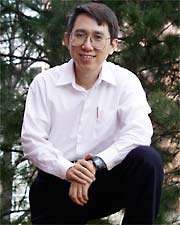Bioreactor boosts chemical fermentation by 50 percent: study

Shang-Tian Yang
A device invented at Ohio State University has dramatically boosted the production of a chemical that performs tasks as diverse as scenting perfume and flavoring Swiss cheese.
Engineers here have used their patented fibrous-bed bioreactor to genetically alter a bacterium so that it produces 50 percent more of the chemical propionic acid than the organism produces normally. And it did so without the aid of chemical additives employed in industry.
The device also reduced the amount of two unwanted byproducts that normally result from propionic acid fermentation — cutting one byproduct by more than half, said Shang-Tian Yang, professor of chemical engineering at Ohio State.
The bioreactor grows cells inside a bundle of fibers. Yang and his colleagues have previously shown that they could control the growth and differentiation of cells by changing the packing density of the fibers in the bioreactor.
Monday at the national meeting of the American Chemical Society in Anaheim, Yang and doctoral student Supaporn Suwannakham reported that they were able to produce 72 grams of propionic acid per liter of sugar solution inside the bioreactor. Traditional fermentation typically yields only 50 grams per liter or less, making the new process 44 percent more effective.
More important to Yang is the fact that he and his team were able to coax the bacterium P. acidipropionici to make more acid without adding chemicals to the mix. They simply immobilized the cells on the fibers so the cells could grow and evolve — or mutate — in a harsh environment.
“Most labs focus on mixing the right chemical or biological cocktail to grow cells,” he said. “We are the only group that I know of that is working to optimize the cells’ physical environment.”
The bioreactor can grow cells for a variety of applications including fermentation, animal cell culture, tissue engineering, and waste water treatment. Since 1998, Yang and his colleagues have used the device to make large quantities of a protein — Developmental Endothelial Locus-1 Protein — for cancer research. A commercial company recently licensed the technology for agricultural applications.
Yang designed the bioreactor as a three-dimensional alternative to the flat petri dishes and trays that scientists traditionally use to culture cells. The fibers anchor living cells in place as they grow and reproduce.
For this latest study, the engineers grew P. acidipropionici in a sugar solution, and gradually adjusted the sugar concentration so the cells would tolerate — and produce — higher concentrations of propionic acid. Tests yielded an average of 72 grams of the acid per liter. The bioreactor also produced 52 percent less succinate and 14 percent less acetate — two chemicals that industry normally has to remove from the fermentation mix before the propionic acid can be used.
When Yang and Suwannakham examined the cells from the bioreactor, they found that the cells had mutated and changed several key enzyme activities. Production of enzymes for propionic acid formation had increased, and the enzyme for succinate production had decreased.
Aside from giving Swiss cheese its characteristic smell and flavor, propionic acid is often used as a preservative and flavor enhancer for a wide variety of cheeses and baked goods.
In the chemical industries, it’s used as an ingredient for dyes, perfumes, pharmaceuticals, herbicides, rubber, and plastic.
With today’s growing emphasis on organic or “all-natural” products, Yang sees a market for propionic acid made without chemical additives in the bioreactor. “A company could conceivably market a product as being made with ‘all-natural’ propionic acid,” he said.
Contact: Shang-Tian Yang, (614) 292-6611; Yang.15@osu.edu
Written by Pam Frost Gorder, (614) 292-9475; Gorder.1@osu.edu
Media Contact
More Information:
http://researchnews.osu.edu/archive/propacid.htmAll latest news from the category: Life Sciences and Chemistry
Articles and reports from the Life Sciences and chemistry area deal with applied and basic research into modern biology, chemistry and human medicine.
Valuable information can be found on a range of life sciences fields including bacteriology, biochemistry, bionics, bioinformatics, biophysics, biotechnology, genetics, geobotany, human biology, marine biology, microbiology, molecular biology, cellular biology, zoology, bioinorganic chemistry, microchemistry and environmental chemistry.
Newest articles

Silicon Carbide Innovation Alliance to drive industrial-scale semiconductor work
Known for its ability to withstand extreme environments and high voltages, silicon carbide (SiC) is a semiconducting material made up of silicon and carbon atoms arranged into crystals that is…

New SPECT/CT technique shows impressive biomarker identification
…offers increased access for prostate cancer patients. A novel SPECT/CT acquisition method can accurately detect radiopharmaceutical biodistribution in a convenient manner for prostate cancer patients, opening the door for more…

How 3D printers can give robots a soft touch
Soft skin coverings and touch sensors have emerged as a promising feature for robots that are both safer and more intuitive for human interaction, but they are expensive and difficult…





















